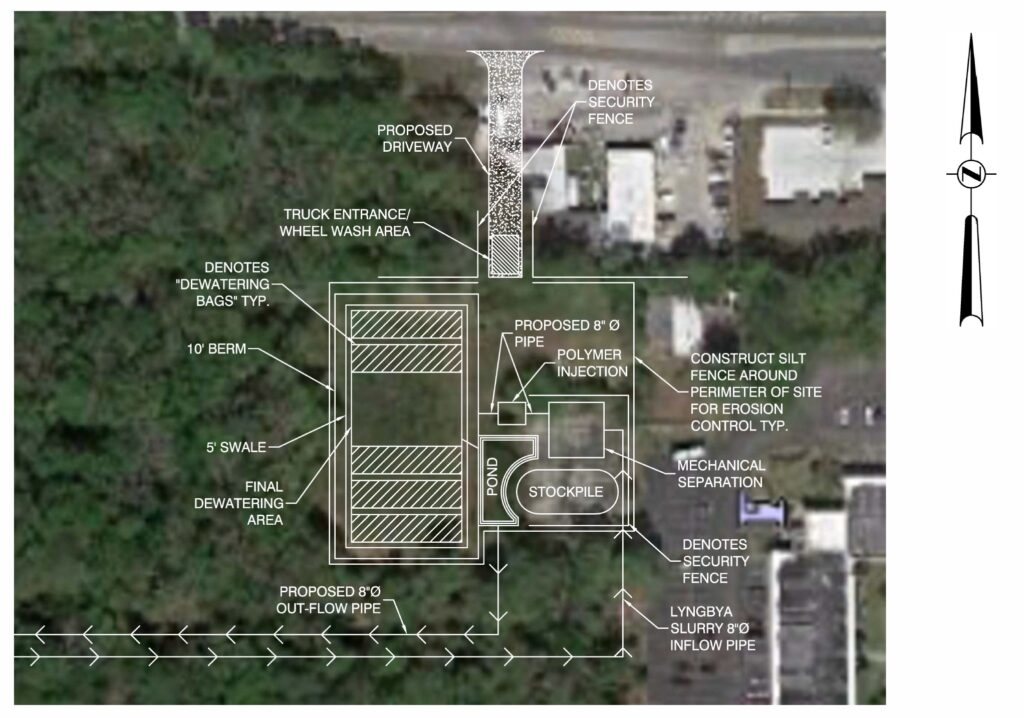Not an overnight miracle
The very first thing to do when cleaning up a river, happens years before the cleanup begins. This cleanup began in 2016. But it’s easy to overlook the time between “we’ve got to do something” and “the first muck is coming out of the river.” Our cleanup site is the result of years of planning.
Read the earlier history articles to understand what it took to get to where we are actually “at the water’s edge” ready to begin removing muck and algae from the river. Read about that here.
Clean up site selection
To begin a cleanup, find a place on the land from where you can stage the operation. That place needs to be large enough for a pumping station. It also needs room for a mechanical separator that removes cell phones, sun glasses, tree limbs, and propeller parts from the organic goop (detritus). And finally, the large sedimentation bags that remove algae from the water need a space that’s about 110 feet by 40 feet, and there will be up to 5 of them.
Plus, there must be room for dump trucks and loaders to work when the bags fill and the organic solids are hauled away. Each bag holds up to 700 cubic yards. A large dump truck holds 20 yards. It takes 2 or 3 acres of open space, close to, if not next to the water. The road from the site must support heavy equipment.
The site should work to clean up as much of the river as possible. Moving equipment from one site to another is expensive and requires time and planning. The Florida DEP approves each site selected before work begins.
Finally, any land use leases should be kept to a minimum so that as many dollars as possible can be spent on removing muck, replanting, and maintaining the newly planted grasses.
Site set up
A clear, flat space is important for a de-watering plant, just like for building a home. Our site had an old building on it. Job one: Remove the building.
Here is the Worksite Layout Plan.

The first thing to consider is access to the water. Where will the hoses go? These are not fire hoses, or even water mains. They are 8 inches across and hundreds of feet long. Sections are rigid and not easily moved. There must be a way to get what is pumped out of the river bottom back to the de-watering site.
Next, where will the big bags go? Each bag is about 100 feet long and 30 feet wide. These bags will fill with water, and separate the algae and organic material from clean water. And each bag will be surrounded by a berm about 3 feet high, that catches and directs the water that comes through the bag sides and top.
When we fill the bags with organic goo, that nitrogen rich product is loaded out using heavy equipment. We need a lot of room to unload the bags. And there are as many as 5 bags. One or two can be actively working filtering the water, while we empty and set up new bags. When a company runs a large de-watering site, it plans these changes.
Working with the Community
Our initial de-watering site is in a non-residential area. Remember that this is an industrial grade effort. We run equipment and it makes some noise. We avoid being a continuous noise source and stop our activity during evening hours and on Sundays and most Holidays. Being away from homes helps with noise as well.
Every few weeks, we unload the large bags. This combination of Lyngbya algae and other organic matter is rich in nitrogen and phosphorous. Farmers can till it into their sandy soils to increase the organic content, hold more moisture, and reduce the need for chemical fertilizer. River muck becomes farm fertilizer.
When the time comes to empty the bags, we bring in dump trucks. A loader fills each truck with up to 20 cubic yards of organic waste. One large bag can fill several dump trucks.
Our de-watering site is near Halls River Road. This larger road offers a good alternative to clean tons of muck from the site. And the road will make moving these large loads safe and speedy.
Keep following this website for updates and progress reports on the Homosassa River Restoration.


